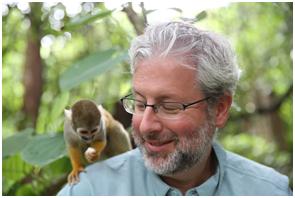In “Your  Inner Monkey,” the third episode of PBS’s Your Inner Fish, Neil Shubin did his usual globe-trotting to meet interesting scientists and fossils. We learned about how our ancestors gained traits that humans now possess—opposable thumbs, finger and toe nails, bipedalism, large brains, and bad backs. It’s a pretty short list (mammary glands were not mentioned) but Shubin gave extensive airtime to visiting two researchers on NCSE’s Advisory Council, Donald Johanson and Tim White.
Inner Monkey,” the third episode of PBS’s Your Inner Fish, Neil Shubin did his usual globe-trotting to meet interesting scientists and fossils. We learned about how our ancestors gained traits that humans now possess—opposable thumbs, finger and toe nails, bipedalism, large brains, and bad backs. It’s a pretty short list (mammary glands were not mentioned) but Shubin gave extensive airtime to visiting two researchers on NCSE’s Advisory Council, Donald Johanson and Tim White.
Shubin also took several entertaining digressions that did not fit neatly into the series format.
The first digression was into research on color vision in squirrel monkeys. Viewers got a reasonable introduction on how color vision works in primates—but the real story is far more interesting. Although Shubin made a point that trichromatic (three-opsin) color vision helps monkeys find the ripest fruit and most scrumptious leaves, he failed to mention that the only New World monkeys (such as squirrel monkeys) with trichromatic vision are less than half of the population of females; the other females and all of the males are red-green color blind. One opsin gene is carried on a somatic chromosome while the other two—which permit red-green differentiation—are found in the same location on the X chromosome. A female needs each X chromosome to code for a different opsin or she will also be red-green color blind. Since males have a single X chromosome, they can only have two opsin varieties—leaving them red-green color blind. Clearly the advantages of trichromatic color vision are not so great or we would expect all New World monkeys to have evolved that trait. Well, a couple of species have, but they are in the minority.
We are told that when researchers introduced a human gene for a third opsin into the retina of a male squirrel monkey named Sam, he was able to differentiate more colors. This was touted as demonstrating the amazing ability of the brain to utilize additional input. Well, yes, maybe. Unmentioned was that Sam has a brain architecture that he shares with his sisters, many of whom are able to differentiate a wide spectrum of colors. A more convincing demonstration of brain plasticity in color differentiation is an experiment where researchers gave a third opsin gene to mice—a dichromatic species—and they gained the ability to differentiate colors their peers could not.
(I wonder if trichromatic female squirrel monkeys in the wild are respected for their heightened ability to find ripe fruit and luscious leaves?)
Another digression was capturing and discussing the small primitive fishlike amphioxus. The same genes that organize the neural tissue in the anterior of amphioxus are involved in the development of the human brain. I kept hoping that Shubin would launch into a chorus of “It’s a Long Way from Amphioxus,” but alas it was not to be.
The three-part series ended back at the anatomy lab where it began except that Shubin did not carve up a cadaver this time. Instead, he sliced open a shark to show us that the basic blueprint of the shark brain is the same as for our brain.
Shubin wrapped things up nicely with the statement that we humans have a deep connection to all life on the planet. I could not agree more.
___________________
View “Your Inner Monkey” online at http://video.pbs.org/video/2365220158/
